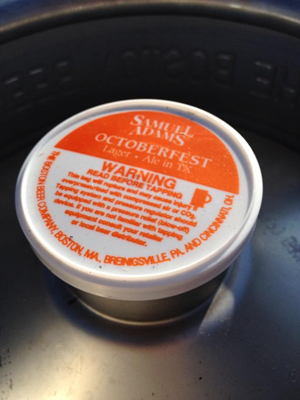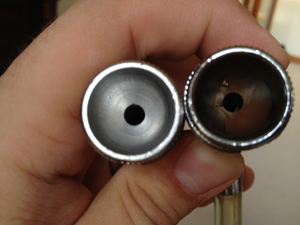It’s been a few months since I’ve built my kegerator. I’ve put about 31 gallons of beer through it, mostly Sam Adams Summer Ale, but I did take a crack at a keg of Boulder Brewing Co’s Mojo IPA. For fathers day my wife and son got me a drip tray along with a Sam Adams Seasonal tap handle. As we approach the fall season I picked up my first Oktoberfest keg and decided it was time for some maintenance. Between each keg I’ve ran cleaner and rinse through my beer line along with cleaning the faucet and coupler. The chrome plated brass shank had seen better days and all of the chrome flaked off and ended up as floaters in a pint every so often. I switched it out for a stainless steel version which should last a long time and not add anything negative to the flavor of the beer. During that project I added two new tools to my Kegerator tool box: a home-made flared wrench (hand me down from my dad) and an Oetiker crimping tool. In fact much of my cleaning parts and tools for the Kegerator come from my dad’s old full-size fridge kegerator from back in the day. The Oetiker clamps are cheap but are a crimp style clamp that not only do a great job of holding and clamping but it is clean and doesn’t chew up the line in the process.



Speaking of line, I took this opportunity to replace the line. I use 3/16″ beer line which has a flow resistance is 3 psi/foot. I went with a longer line that allows for more slack, giving easier movement of the keg, but also requires a change to my co2 setting. Between running a nice cool temperature (between 34 and 36* F) and a low co2 setting (6 psi) I barely have any foaming issues. I also used copper tubing to help route the beer line, and it does bring a little off the cool temperature up into the tower.
In order to reduce foaming you want to try to keep the tap pressure between 0 and 1 psi. The length of the beer line will play a key role in your co2 regulator setting. My original beer line was 5 feet long and the faucet is about 2 feet above the bottom of the copper tube. The pressure will loose 0.5 psi for every vertical foot it travels.
6 psi (-1 for keg pressure) (-1.5 for height [3 feet / 2]) / 5 feet * 3 psi resistance
3.5 / 15 = 0.23 psi tap pressure
I stepped up to 7 feet of line and bumped my regulator pressure up to 9 psi …
6.5 / 21 = 0.31 psi tap pressure
At these tap pressures the beer has a smooth and somewhat slow flow and yields a perfect 1″ of head on a properly poured pint.